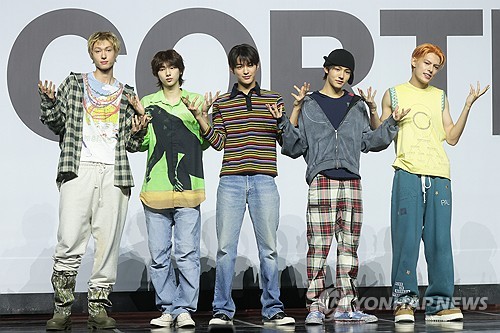Why is CORTIS's arrival so charged?
A new beginning has shaken the city.
In August 2025, five-member boy group CORTIS officially debuted, and the music world reacted immediately.
When Martin, James, Juhun, Sunghyun, and Gunho took the stage, the audience leaned forward as if to verify the group's color.
The debut date was more than a calendar mark.
Hive (the company formerly known as BigHit Music) introduced a new rookie group for the first time in six years, and that fact speaks to both internal strategy and external expectation.
Already having global acts like BTS and TXT as precedents, the launch comes with opportunity and burden at once.

A line from the debut showcase lingered.
“Our priority is to show you our music and who we are,” the group said — a statement that read as more than an opening remark; it sounded like a declaration of identity.
Moreover, it suggested the members intend to take an active creative role rather than be purely performers.
"A stage made by the audience"
The first meeting with the public is a test.
On debut day, online communities and social media exploded with both praise and skepticism.
Fans celebrated a “bibimbap-like harmony” (a Korean metaphor for diverse elements blending well), while others worried the group would be labeled a “younger sibling” to existing acts.
That reaction is not superficial.
As global K-pop expands — with cross-media hits like recent Netflix anime boosting the genre’s visibility — a new group sends multiple signals at once.
Hive’s resources and system are definite advantages. However, they also heighten comparison pressure from media and fans.
Small ripples making a big wave
History repeats and varies.
BigHit debuted BTS in 2013 and introduced TXT in 2019. Now, in 2025, CORTIS represents another variation on that progression.
The name CORTIS, taken from the phrase “COLOR OUTSIDE THE LINES,” suggests a spirit of breaking molds. Meanwhile, the slogan itself raises expectations about what “different” might mean in practice.
All five members participated in songwriting or production work with Hive artists before debut, which supports the idea that this is a skill-based rookie group.
On the other hand, that experience can be read as existing in the shadow of senior acts. This dual reading highlights structural features of the music industry, where the same fact can support very different narratives.
Winds of change, Hive’s choice
Strategic choices are ultimately judged by results.
From a corporate angle, Hive likely aimed to expand its global portfolio through CORTIS.
Therefore, new talent investment and long-term brand building must proceed together if the plan is to work.
Meanwhile, a crowded market forces fast performance from newcomers.
Hive’s support brings advantages, but that influence can quickly turn into a measuring stick against predecessors.
So the question becomes whether CORTIS can find its own path between institutional expectations and creative independence.
CORTIS declares a new challenge
Neither the applause nor the doubts are one-dimensional.
From now on, we need to examine both positions calmly.
The following sections summarize each view in detail.
The pro side’s case is clear.
First, Hive’s infrastructure and know-how offer a real edge for global expansion. BTS and TXT are not just success stories; they are potential playbooks for artist development, marketing, and worldwide operations.
Second, the members’ hands-on participation in songwriting and production signals musical capability beyond mere performance. Studio credits by Martin, James, Juhun, Sunghyun, and Gunho point to the possibility that they can be creators, not only idols.
Third, the team name’s message — to color outside the lines — can be read as an attempt to reinterpret K-pop norms and experiment within the system.
Consequently, supporters argue CORTIS could diversify Hive’s offerings and commercially scale artistic experiments. Moreover, a widening global fandom might reward creative risks over the long term.
Critics’ concerns are also convincing.
The clearest issue is the “shadow of seniors.”
BTS and TXT’s achievements can be both blessing and burden for CORTIS. Media and public discourse tend to judge newcomers by comparison, and escaping that benchmark may be difficult.
Second, the changing market demands rapid adaptation. Algorithm-driven platforms, faster visual content consumption, and a flood of new acts make it harder for any rookie to establish a unique identity.
Third, forming a stable fandom is uncertain. Early hype can turn quickly into disappointment, creating financial and emotional strains for a new group.
Finally, the rhetoric of “creative freedom” can differ from the actual autonomy available inside a corporate system. In other words, institutional structures may limit experimentation more than the public realizes.
These two perspectives are not mutually exclusive.
The resources and possibilities emphasized by supporters form a real foundation. At the same time, critics point to the preconditions required for those possibilities to materialize.
Therefore, CORTIS’s future depends not only on external success but on how much internal autonomy and a sustainable creative structure the group can secure.
CORTIS’s August 2025 debut marks the intersection of Hive’s strategic move and the group’s musical declaration.
The members’ collective creative involvement and the “color outside the lines” identity suggest experimental potential, yet comparison pressures from BTS and TXT remain a practical obstacle.
Supporters cite Hive’s infrastructure and member talent as reasons for optimism, while critics point to the shadow of predecessors and fierce market competition as reasons for caution.
Ultimately, the key is whether CORTIS can balance independent creation with the steady building of a fandom. The question remains: how will you read their next step?